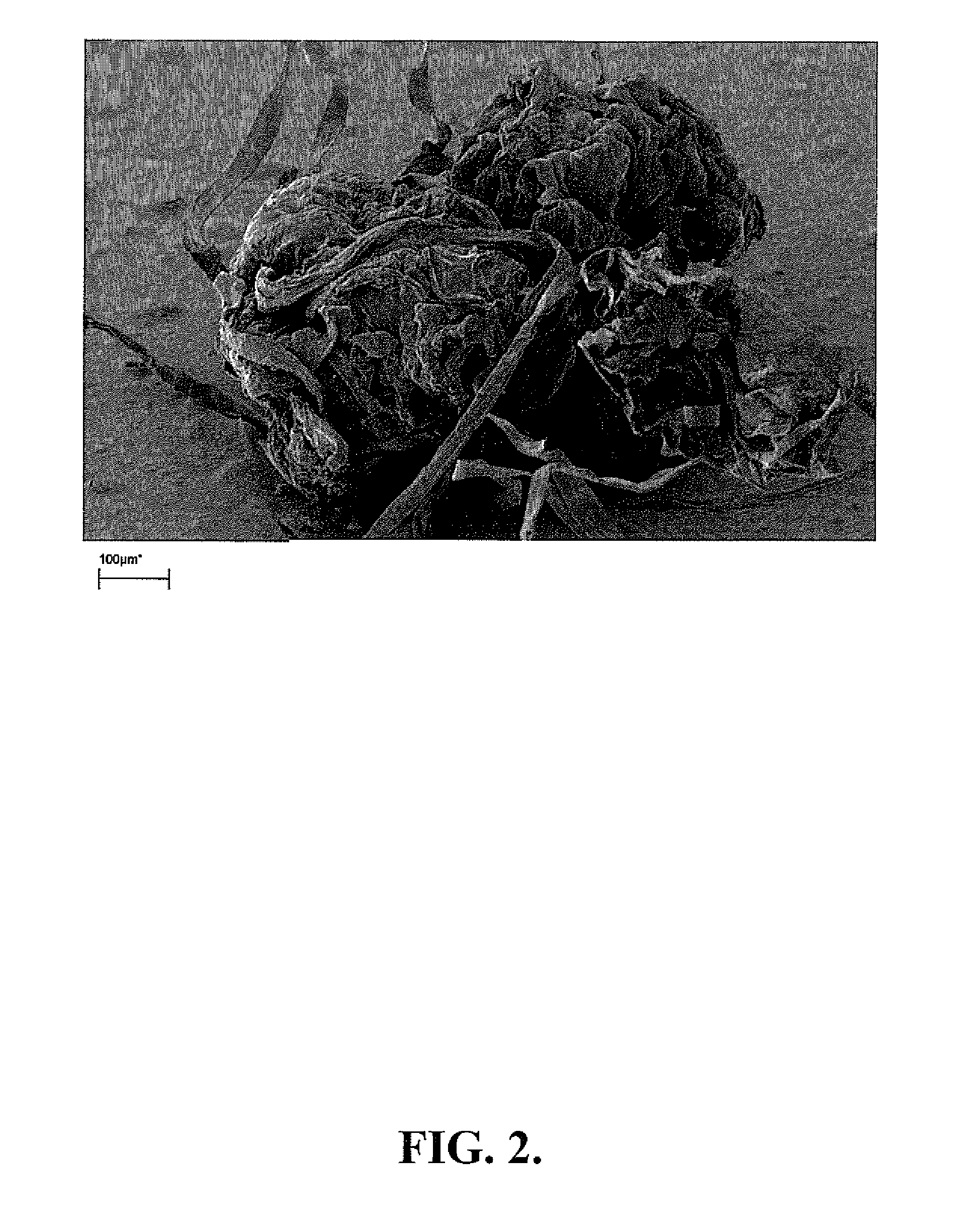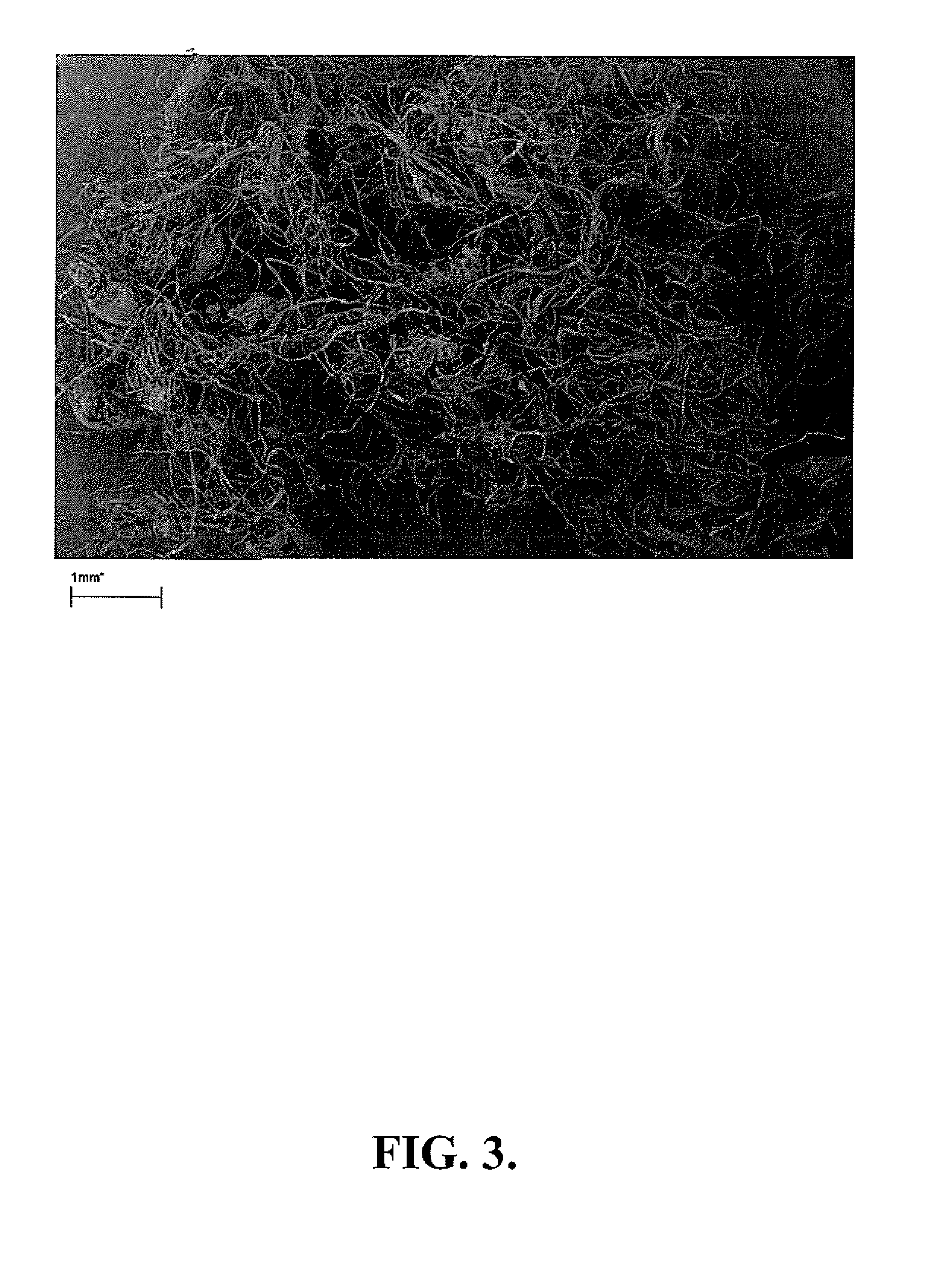Fibrous superabsorbent composite containing cellulose
a superabsorbent and composite technology, applied in the field of fibrous superabsorbent composite containing cellulose, can solve the problems of high cost, inefficiency in the use of sap, and a lot of interstitial liquid in the product,
- Summary
- Abstract
- Description
- Claims
- Application Information
AI Technical Summary
Problems solved by technology
Method used
Image
Examples
example 1
The Preparation of Representative Superabsorbent Particles (Flakes): Ammonium Zirconium Carbonate and Boric Acid Crosslinking
[0100]In this example, the preparation of representative superabsorbent composite crosslinked with ammonium zirconium carbonate is described.
[0101]Prepare a solution of CMC 9H4F 10.0 g OD in 900 ml deionized water with vigorous stirring to obtain a smooth solution. Fully dissolve 0.6 g guar gum in 50 ml DI water and mix well with the CMC solution. Mix the solution for further one hour to allow complete mixing of the two polymers.
[0102]Blend the polymer mixture in the blender for 5 minutes. Fully dissolve boric acid 0.1 g in 30 ml DI water. Dilute 2.0 g ammonium zirconium carbonate solution (15% ZrO2) with 20 ml DI water. Transfer ammonium zirconium carbonate solution and boric acid solution to the polymer solution and blend for 5 minutes. Pour the gel into a Teflon coated pan and dry in the oven at 60° C. Grind the dry film in a coffee grinder and sieve. Colle...
example 2
The Preparation of Representative Superabsorbent Particles (Flakes): Aluminum Sulfate / Boric Acid Crosslinking
[0104]In this, example, the preparation of representative superabsorbent composite crosslinked with aluminum sulfate and boric acid is described.
[0105]Prepare a solution of CMC 9H4F 10.0 g OD in 900 ml deionized water with vigorous stirring to obtain a solution. Dissolve 0.6 g guar gum in 50 ml DI water and mix well with the CMC solution. Mix the solution for further one hour to allow complete mixing of the two polymers.
[0106]Blend the polymer mixture in the blender for 5 minutes. Fully dissolve boric acid 0.1 g in 30 ml DI water. Dissolve 0.4 g aluminum sulfate octadecahydrate 20 ml DI water. Transfer boric acid solution and aluminum sulfate solution to the polymer solution and blend for 5 minutes to mix well. Pour the gel into a Teflon coated pan and dry in the oven at 60° C. Grind the dry film in a coffee grinder and sieve. Collect 300-800 μm fraction for testing.
[0107]T-b...
example 3
The Preparation of Representative Superabsorbent Particles (Flakes): Tyzor TE and Boric Acid Crosslinking
[0108]In this example, the preparation of representative superabsorbent composite crosslinked with Tyzor TE and boric acid is described.
[0109]Prepare a solution of CMC 9H4F 10.0 g OD in 900 ml deionized water with vigorous stirring to obtain a smooth solution. Dissolve 0.6 g guar gum in 50 ml DI water and mix well with the CMC solution. Mix the solution for farther one hour to allow complete mixing of the two polymers.
[0110]Blend the polymer mixture in the blender for 5 minutes. Dissolve boric acid 0.2 g in 30 ml DI water. Dilute 0.2 g Tyzor TE with 20 ml DI water. Transfer Tyzor TE solution and boric acid solution to the polymer solution and blend for 5 minutes to mix well. Pour the gel into a Teflon coated pan and dry in the oven at 60° C. Grind the dry film in a coffee grinder and sieve. Collect 300-800 μm fraction for testing.
[0111]T-bag test for free swell 43.92 g / g; centrif...
PUM
| Property | Measurement | Unit |
|---|---|---|
| Fraction | aaaaa | aaaaa |
| Percent by mass | aaaaa | aaaaa |
| Percent by mass | aaaaa | aaaaa |
Abstract
Description
Claims
Application Information
 Login to View More
Login to View More - R&D
- Intellectual Property
- Life Sciences
- Materials
- Tech Scout
- Unparalleled Data Quality
- Higher Quality Content
- 60% Fewer Hallucinations
Browse by: Latest US Patents, China's latest patents, Technical Efficacy Thesaurus, Application Domain, Technology Topic, Popular Technical Reports.
© 2025 PatSnap. All rights reserved.Legal|Privacy policy|Modern Slavery Act Transparency Statement|Sitemap|About US| Contact US: help@patsnap.com



